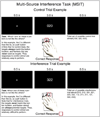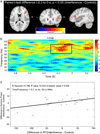Evidence for a motor gamma-band network governing response interference
- PMID: 23454050
- PMCID: PMC3817211
- DOI: 10.1016/j.neuroimage.2013.02.013
Evidence for a motor gamma-band network governing response interference
Abstract
The gamma-band response is thought to represent a key neural signature of information processing in the human brain. These brain signals have been associated with a variety of sensory modalities (vision, sensation, and audition) and also following basic motor responses, yet the functional significance of the motor gamma-band response remains unclear. We used the Multi-Source Interference Task (MSIT) to assess the sensitivity of these cortical motor gamma-band rhythms to stimuli producing response interference. We recorded MEG from adult participants (N=24) during MSIT task performance and compared motor gamma-band activity on Control and Interference trials. Reaction time on MSIT Interference trials was significantly longer (~0.2 s) for all subjects. Response interference produced a significant increase in motor gamma-band activity including ~0.5 s sustained increase in gamma-band activity from contralateral primary motor area directly preceding the response. In addition, activation of increased right Inferior Frontal Gyrus (R-IFG) was observed at gamma-band frequencies ~0.2 s prior to the button press response. Post-hoc analysis of R-IFG gamma-band activity was observed to correlate with reaction time increases to response interference. Our study is the first to record MEG during MSIT task performance. We observed novel activity of the motor gamma-band on interference trials which was sustained prior to the response and in novel locations including contralateral (BA6), and R-IFG. Our results support the idea that R-IFG is specialized structure for response control that also functions at gamma-band frequencies. Together, these data provide evidence for a motor gamma-band network for response selection and maintenance of planned behavior.
Copyright © 2013 Elsevier Inc. All rights reserved.
Conflict of interest statement
Disclaimer: No author declares a conflict of interest. This study was supported in part by NIH grant R01DC008871 (TR) and a grant from the Nancy Lurie Marks Family Foundation (NLMFF), and Autism Speaks. This research has been funded (in part) by a grant from the Pennsylvania Department of Health. The Pennsylvania Department of Health specifically disclaims responsibility for any analyses, interpretations or conclusions. Dr. Roberts gratefully acknowledges the Oberkircher Family for the Oberkircher Family Chair in Pediatric Radiology at Children’s Hospital of Philadelphia.
Figures






References
-
- Adjamian P, Holliday IE, Barnes GR, Hillebrand A, Hadjipapas A, Singh KD. Induced visual illusions and gamma oscillations in human primary visual cortex. Eur. J. Neurosci. 2004;20:587–592. - PubMed
-
- Alegre M, Gurtubay IG, Labarga A, Iriarte J, Malanda A, Artieda J. Alpha and beta oscillatory changes during stimulus-induced movement paradigms: effect of stimulus predictability. Neuroreport. 2003;14:381–385. - PubMed
-
- Alegre M, Lopez-Azcarate J, Obeso I, Wilkinson L, Rodriguez-Oroz MC, Valencia M, Garcia-Garcia D, Guridi J, Artieda J, Jahanshahi M, Obeso JA. The subthalamic nucleus is involved in successful inhibition in the stop-signal task: a local field potential study in Parkinson’s disease. Exp. Neurol. 2012;239C:1–12. - PubMed
-
- Andersson J, Smith S, Jenkinson M. FNIRT - FMRIB’s Non-linear Image Registration Tool; In Fourteenth Annual Meeting of the Organization for Human Brain Mapping - HBM.2008.
Publication types
MeSH terms
Grants and funding
LinkOut - more resources
Full Text Sources
Other Literature Sources

